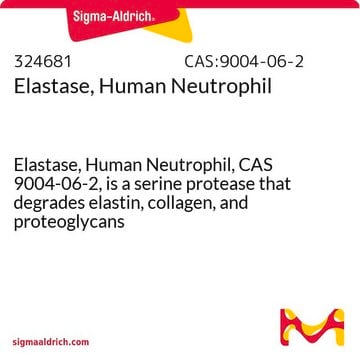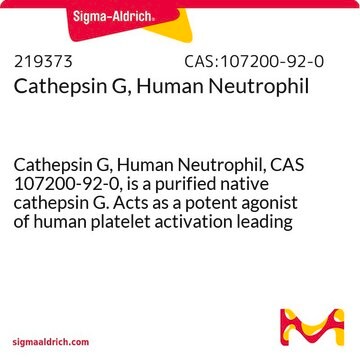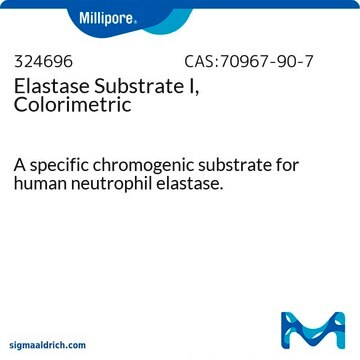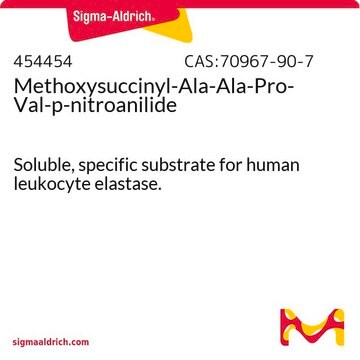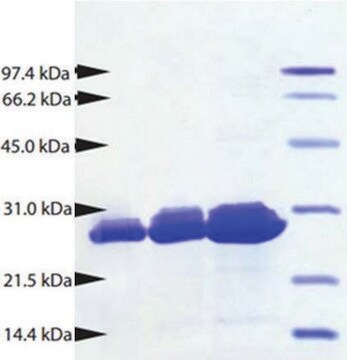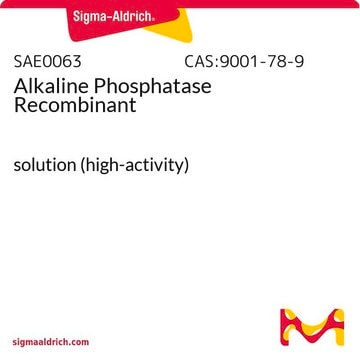C5108
Cathepsin G from human sputum
≥0.2 units/mg protein, salt-free, lyophilized powder
Sign Into View Organizational & Contract Pricing
All Photos(1)
About This Item
CAS Number:
MDL number:
UNSPSC Code:
12352200
NACRES:
NA.32
Recommended Products
biological source
human sputum
form
salt-free, lyophilized powder
specific activity
≥0.2 units/mg protein
UniProt accession no.
shipped in
wet ice
storage temp.
2-8°C
Gene Information
human ... CTSG(1511)
Biochem/physiol Actions
Cathepsin G has pro-apoptotic activity and can activate caspases in vitro.
Storage Class Code
13 - Non Combustible Solids
WGK
WGK 3
Flash Point(F)
Not applicable
Flash Point(C)
Not applicable
Choose from one of the most recent versions:
Already Own This Product?
Find documentation for the products that you have recently purchased in the Document Library.
E D Son et al.
Dermatology (Basel, Switzerland), 224(4), 352-360 (2012-07-05)
Cathepsin G, a serine protease that is activated by ultraviolet (UV) radiation, increases matrix metalloproteinase-1 (MMP-1) expression in fibroblasts through fibronectin (Fn) fragmentation and promotes the conversion of proMMP-1 to active MMP-1. This study investigated whether [2-[3-[[(1-benzoyl-4-piperidinyl)methylamino]carbonyl]-2-naphthalenyl]-1-(1-naphthalenyl)-2-oxoethyl]-phosphonic acid (KPA), a
Jun Zhang et al.
American journal of physiology. Renal physiology, 303(4), F593-F603 (2012-06-08)
The renin-angiotensin system (RAS) is well studied for its regulation of blood pressure and fluid homeostasis, as well as for increased activity associated with a variety of diseases and conditions, including cardiovascular disease, diabetes, and kidney disease. The enzyme renin
Prasad Tongaonkar et al.
PloS one, 7(3), e32469-e32469 (2012-03-27)
The azurophilic granules of human neutrophils contain four α-defensins called human neutrophil peptides (HNPs 1-4). HNPs are tridisulfide-linked antimicrobial peptides involved in the intracellular killing of organisms phagocytosed by neutrophils. The peptides are produced as inactive precursors (proHNPs) which are
Hitoshi Tsujimoto et al.
PloS one, 7(2), e29964-e29964 (2012-03-03)
Black flies (Diptera: Simuliidae) feed on blood, and are important vectors of Onchocerca volvulus, the etiolytic agent of River Blindness. Blood feeding depends on pharmacological properties of saliva, including anticoagulation, but the molecules responsible for this activity have not been
Ewa Gorodkiewicz et al.
Analytical biochemistry, 423(2), 218-223 (2012-03-01)
A specific surface plasmon resonance imaging (SPRI) array biosensor for the determination of the enzymatically active cathepsin G (CatG) has been developed. For this purpose, a specific interaction between an inhibitor immobilized onto a chip surface and CatG in an
Our team of scientists has experience in all areas of research including Life Science, Material Science, Chemical Synthesis, Chromatography, Analytical and many others.
Contact Technical Service